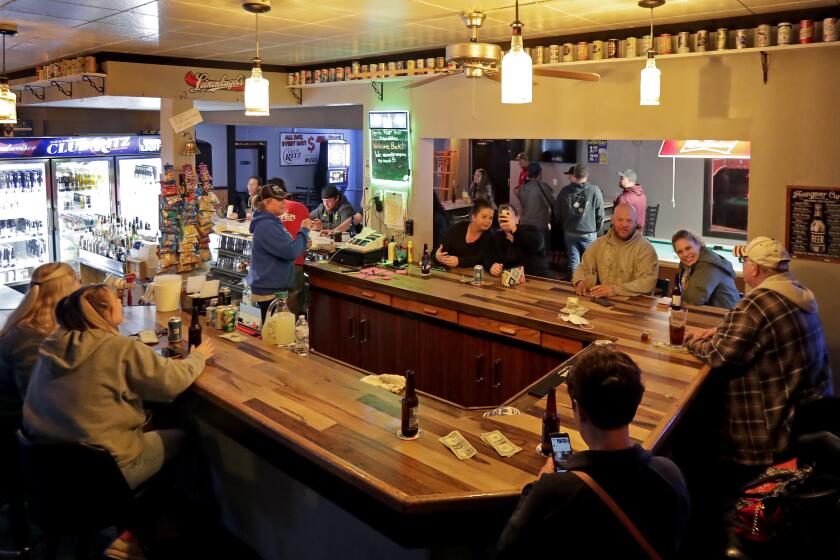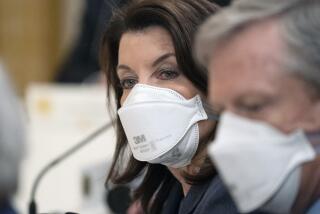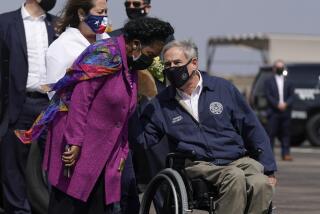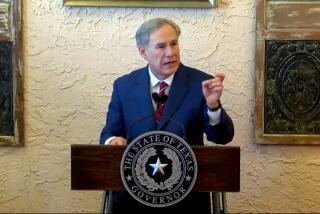Coronavirus divide: Battle over reopenings across the U.S. is increasingly partisan and bitter
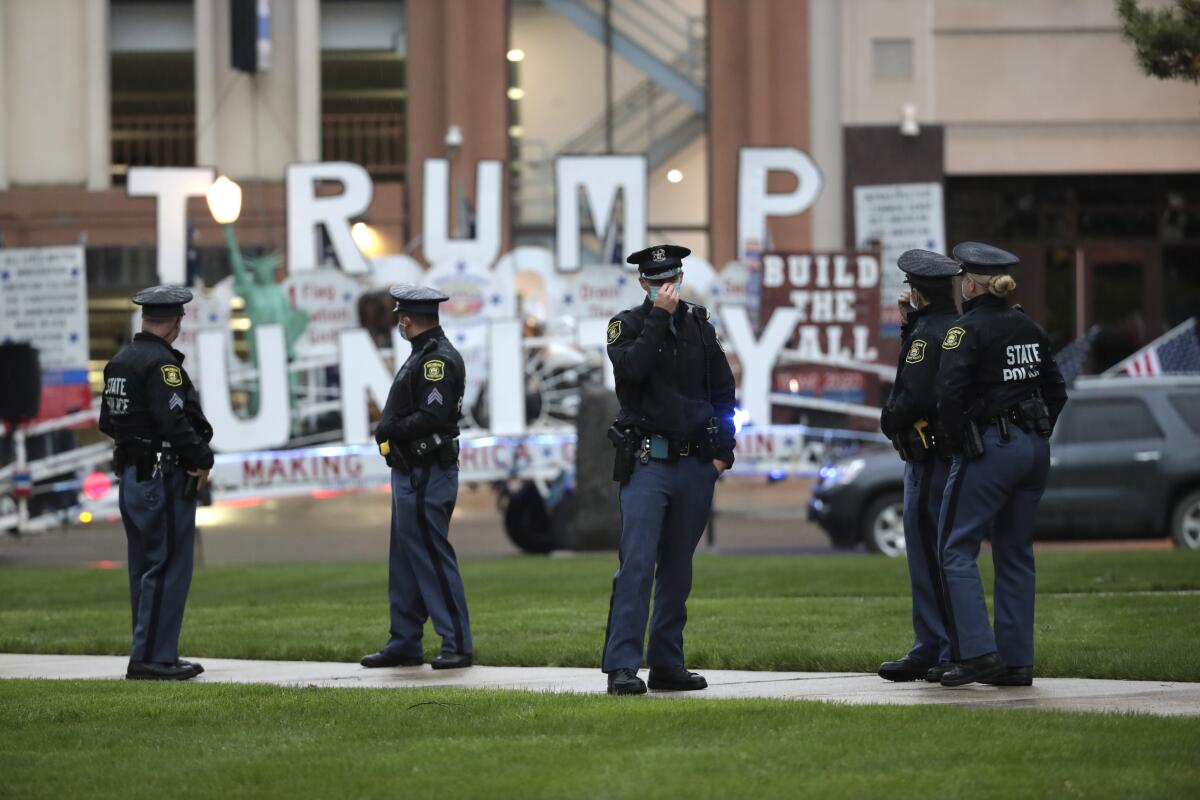
- Share via
Urged on by President Trump, Republican officials in several battleground states, including Wisconsin, Michigan and Pennsylvania, are ramping up pressure on Democratic governors to move faster on reopening their economies, despite experts’ warnings of a surge in infections and deaths.
The mounting pressure comes as the number of jobless Americans continues to grow across the nation. Nearly 3 million Americans filed for unemployment benefits last week, according to new figures released Thursday by the Labor Department, bringing the total number of claims to 36 million since the economic shutdowns in response to the coronavirus outbreak began.
Meanwhile, the death toll from COVID-19, the disease caused by the novel coronavirus, continues to climb. More than 85,000 people in the U.S. have died of COVID-19, according to data compiled by Johns Hopkins University. And more than 1.4 million people have tested positive for the novel coronavirus, the university reports.
The battle over stay-at-home orders and the pace of allowing businesses to reopen have taken an increasingly partisan bent.
In Pennsylvania, the Democratic governor has called out Republican leaders flouting his restrictions as cowards. In Wisconsin, the state Supreme Court took Republicans’ side in throwing out the Democratic governor’s stay-at-home order. In Michigan, Gov. Gretchen Whitmer faced armed protesters again Thursday at the state Capitol; the Democrat — who is on the list of potential vice presidential picks for Joe Biden — has faced sharp criticism from GOP legislators as well as Trump. And in Texas, the attorney general has threatened Democratic officials whose cities’ restrictions are more stringent than those put in place by the Republican governor.
Health experts have warned that it’s dangerous to fully reopen before widespread testing and contract tracing are in place.
Ousted director testifies that Trump has no plan and unrealistic timetable for a coronavirus vaccine
Rick Bright testifies before the House Committee on Energy and Commerce’s health subcommittee after he filed a whistle-blower complaint.
Pennsylvania Gov. Tom Wolf, whose state had more than 4,200 people die of COVID-19, has faced growing resistance from Republican legislators as well as county commissioners in the central and eastern parts of the state.
“We’re trying to get things moving in a safe and responsible manner because this thing is turning into a pressure cooker,” said state Rep. Dan Moul, a Republican from conservative Adams County. “This thing is going to blow up if [Wolf] doesn’t make a move soon.”
Some counties have threatened to defy Wolf’s directives. The governor’s plan reopens the state in phases. More than half of the counties in the state have already started to reopen, Wolf said in a phone interview with NBC affiliate WGAL-TV on Thursday.
Thirteen more are slated to be under Wolf’s “yellow” phase by Friday, which means child-care centers can reopen and retail stores can resume operations, but under strict social distancing guidelines. Large gatherings of more than 25 people are still prohibited in those “yellow” counties, and gyms, hair salons and theaters must remain closed.
The rest of the state, however, remains under Wolf’s “red” phase, in which stay-at-home orders are still in place, large gatherings prohibited and restaurants and bars permitted to take only carry-out or delivery orders.
“We’re all fighting this war together. We can’t run up the white flag,” Wolf told WGAL-TV. “We have got to fight this to the end and make sure that we’re going everything we can to keep people safe. Again, I don’t think that the commonwealth has been unreasonable.”
Wolf has threatened to punish counties that vowed to reopen despite his orders by threatening to withhold coronavirus aid, and he said business owners who reopen would risk losing their licenses to operate. Some leaders have backed down, but others appear to be moving ahead.
“Come this Friday, we plan on opening because we’ve been getting hundreds of emails, text messages and phone calls that these business owners are on the brink of closing down,” Daniel Camp III, the Republican chairman of the Beaver County board, told a joint state Senate hearing Wednesday.

Trump, who had tweeted Monday that Pennsylvanians “want their freedom now,” took a tour at a medical supply facility near Allentown on Thursday and spoke about ramping up production of personal protective equipment. Images showed him surrounded by people wearing masks; the president has said he will not wear one, explaining “it’s not for me.”
“We have to get your governor of Pennsylvania to start opening up a little bit,” Trump said during the tour.
Ahead of Trump’s visit to Pennsylvania, Biden, the presumptive Democratic presidential nominee, accused the president of contributing to the politicization of the widening debate on how and when to lift coronavirus restrictions.
“At a time when we should be uniting our country, President Trump is trying to split Pennsylvanians into dueling camps, casting Democrats as doomsayers hoping to keep America grounded and Republicans as freedom fighters trying to liberate the economy,” Biden said in a statement Thursday. “This is a false choice, and it’s just his latest tactic in his mission of dividing Americans.”
In Michigan, a couple hundred people, many of them armed, took to the state Capitol on Thursday to protest Whitmer’s stay-at-home order.
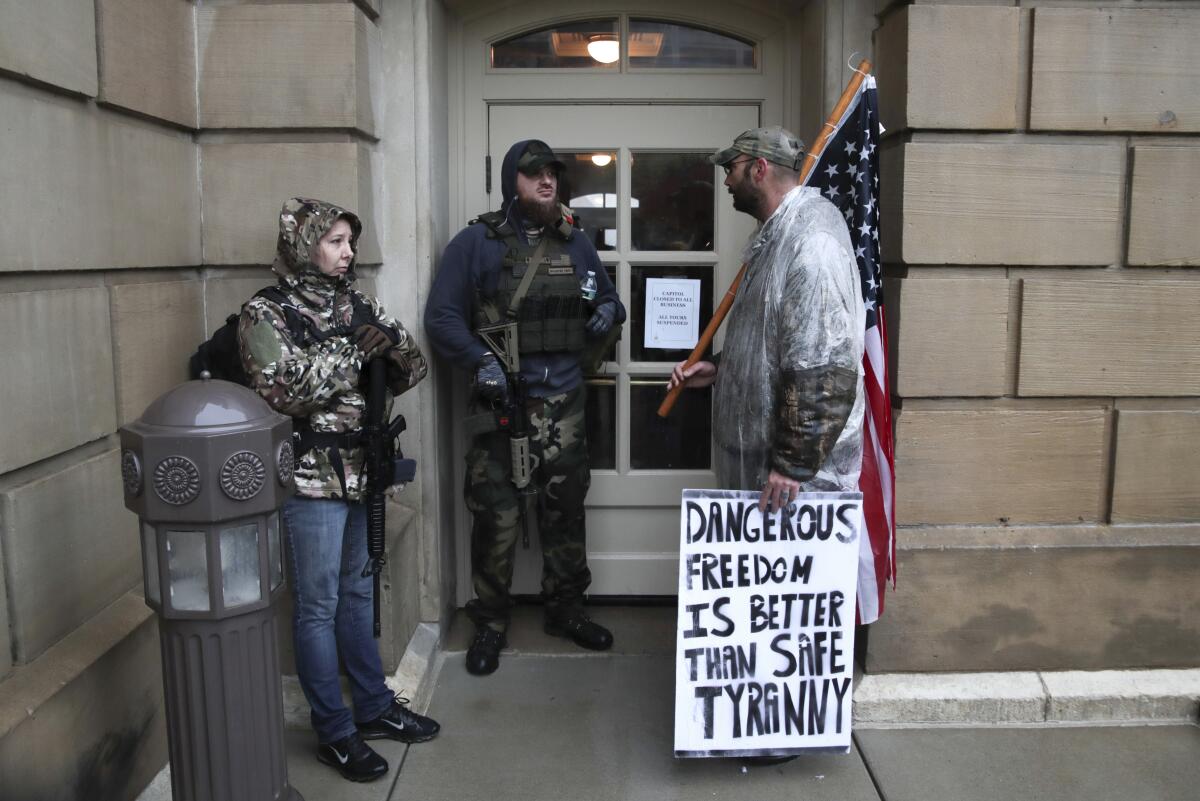
The governor, who was sued last week by the GOP-controlled state House and Senate last week over claims that she had overstepped her authority by extending the state’s stay-at-home orders, continues to urge people to abide by social distancing guidelines.
“I don’t particularly want to see people congregating, period. We know that contributes to spread,” Whitmer said Wednesday. “But if people are going to come down and demonstrate, do it in a responsible way. That’s what we ask.”
She said lives have been saved because of the state’s stay-at-home order, which is effective through May 28.
“If we had not taken the action that we did, more people would have died and the disease would have spread much further than it did,” Whitmer said.
In Wisconsin, Gov. Tony Evers on Thursday warned that as some cities lift restrictions and others clamp down after the state Supreme Court threw out his stay-at-home order, the patchwork of rules could lead to “massive confusion.”
“Apparently they believe that different rules are OK,” Evers said of Republicans. “I can’t imagine another state that is in this predicament.”
The conservative-majority state Supreme Court had sided with Republicans in a lawsuit over Evers’ restrictions, which were to last through May. The 5-4 decision means that Evers would need to work with the Republican-controlled Legislature to come up with a new plan.
But Republican Assembly Speaker Robin Vos minimized Evers’ concerns and said Wisconsin doesn’t “necessarily need a statewide approach.”
“We already know that local health departments have the ability to utilize their power, which is already there to deal with those situations if they feel it’s unsafe,” Vos said.
Trump cheered the court ruling, calling it “a win” for Wisconsin.
“Its Democrat Governor was forced by the courts to let the State Open,” Trump tweeted Thursday morning. “The people want to get on with their lives. The place is bustling!”
A court ruling tossing Wisconsin’s stay-at-home order sparked chaos as some bars opened immediately and other locales kept restrictions in place.
Officials in some cities across Wisconsin, however, are choosing to continue following the state’s stay-at-home orders. Health officials in Milwaukee are still requiring residents to abide by the orders. In Dane County, home to the state capital of Madison, officials imposed a replacement order similar to Evers’ statewide one.
Meanwhile, governors in other states announced plans to loosen restrictions in the coming days and weeks.
Ohio Lt. Gov. Jon Husted said gyms and public pools will be able to reopen starting May 26 if businesses meet safety protocols and hygienic measures. He added that by May 31, child-care facilities will also be allowed to reopen, albeit with fewer children in each classroom and as long as staff can ensure additional cleaning measures.
Rhode Island Gov. Gina Raimondo announced that children will be allowed to go to summer camp starting June 29. “For their mental and emotional and intellectual development and health, I think we need to try our best to operate summer camps this summer,” Raimondo said Thursday during a news conference.
In Minnesota, small retail stores will be allowed to reopen starting Monday, when the state’s stay-at-home order expires. Bars, restaurants and hair salons will remain closed but could reopen as early as June 1, Gov. Tim Walz said Wednesday.
“The stay-at-home order is expiring and the dials are turning, but that doesn’t mean we are carefree and can return to the way things were,” Walz said. “It means we have to stay safe, take care, care for our own health and care for our neighbor.”
Among the larger businesses planning to reopen June 1: Bloomington’s Mall of America, one of the largest shopping complexes in North America with more than 500 stores and restaurants.
“It is important to know that while Mall of America will reopen on June 1, not all retailers within our building will open immediately. We understand it may be longer before some are ready to reopen,” the mall said in a statement Thursday.
In New York, Gov. Andrew Cuomo said Thursday that five upstate and central regions are on track to begin a phased reopening Friday. Those regions have met the seven benchmarks suggested by public health officials. By comparison, New York City has met only four.
Under the plan, construction and agricultural operations will resume, and retail stores will be allowed to reopen for curbside or in-store pickup only. Local officials will monitor the number of coronavirus cases and must ensure businesses and consumers comply with social distancing requirements, Cuomo said.
He added that the state had reported 157 more COVID-19 deaths since Wednesday. That number is down from 166 the day before.
Cuomo cautioned, however, that “phased reopening does not mean the problem has gone away.”
“We have control of the problem because of what we did and because of our individual responsibility and our individual actions, and that has to be maintained.”
The Associated Press contributed to this report.
More to Read
Sign up for Essential California
The most important California stories and recommendations in your inbox every morning.
You may occasionally receive promotional content from the Los Angeles Times.
